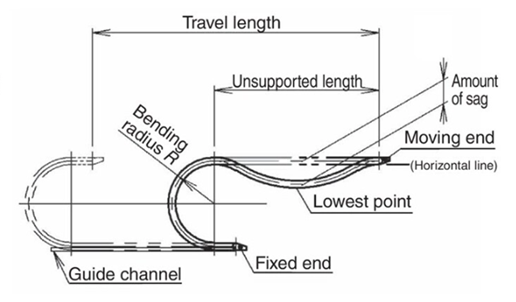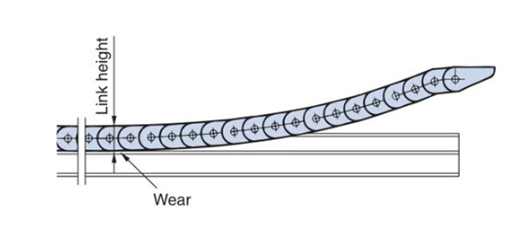Technical Data Cable Carriers (CABLEVEYOR) - Usage limitations of cable carrier
Cable carrier service life
As the cable carrier moves (cycles), the pins and holes in the link connections will wear or the no-back-bend limiting portion will wear, causing sag in the unsupported length portion (see the figure to the right).
This will result in the product being determined as having reached the end of its service life when it is no longer possible to guarantee protection of the cables/hoses and stable operation of the cable carrier.
This determination is made when the smaller of 1 or 2 below is reached.
Unsupported length sag limits (guideline)
1.10% of unsupported length
2.Cable carrier bending radius (R) amount
(ex.)
Unsupported length :
500mm(⇒500mm×0%=50mm)→Sag amount limit (guideline): 50 mm
Cable carrier bending radius :R55

■Should the cable carrier become broken, cracked, or otherwise damaged due to deterioration caused by age, the cable carrier is determined to have reached the end of its service life.
Factors that affect service life
Cable carrier may reach the end of its service life relatively quickly in the following cases.
- 1.High acceleration/deceleration or operating frequency
- 2.Presence of wear caused by abrasives such as dust.
- 3.External vibrations.
- 4.Poor installation.

■Cable carrier installation accuracy guidelines (recommended)
- ・Misalignment (ε) of moving end and fixed end positions is smaller than the allowable value
- ・Mounting height (H') is within the recommended value range 〔Note :Do not install at the total height (H). 〕
- ・Leeway space (S) is larger than the recommended value
- ・Provide a guide channel (for cable carrier)
Prolonging cable carrier service life
To prolong the service life of cable carrier components, installation of support rollers or support plates from the start of operation is recommended to limit sag.

Note) When adding support rollers or support plates if the sag amount in the unsupported length portion is increasing, the installation position (height) or—for support plates—the shape (where the unsupported length portion transfers to the channel) must be set with consideration for the amount of sag in the unsupported length portion at that time.

Guideline for the service life of the gliding arrangement
With the gliding arrangement, the inside of the link wears down with usage. The guideline for replacement is when the amount of link height wear (amount of gliding shoe wear for gliding shoes) reaches the allowable value (table to right). For TKP58H39 with gliding shoes, TKP68H46 with gliding shoes, TKP91 (H56, H80), TKC91 (H56, H80), TKMK Series and TKMT Series, only the gliding shoes can be replaced. For the effect of prolonging the service life of gliding shoes, refer to page of the gliding arrangement.
| Size | Allowable wear (mm) | |
|---|---|---|
| No gliding shoes | with gliding shoe | |
| TKP35H22 | 1 | - |
| TKP45H25 | 1.5 | - |
| TKP58H39 | 1.5 | 5 |
| TKP62H34 | 1 | - |
| TKP68H46 | 1.5 | 5 |
| TKP90H50 | 1.5 | - |
| TKP125H74 | 1.5 | - |
| TKP91H56 | - | 7 |
| TKP91H80 | - | 7 |
| TKC34H25 | 1 | - |
| TKC47H36 | 1 | - |
| TKC64H50 | 1.5 | - |
| TKC85H68 | 1.5 | - |
| TKC91H56 | - | 7 |
| TKC91H80 | - | 7 |
| TKMK47H28/TKMT47H26 | - | 1.5 |
| TKMK65H42/TKMT65H38 | - | 1.5 |
| TKMK95H58/TKMT95H54 | - | 1.5 ※ |
| TKMK125H72/TKMT125H68 | - | 1.5 ※ |

※Types with even larger values (different gliding shoe thickness) are also available. Contact a Tsubaki representative for further information.

